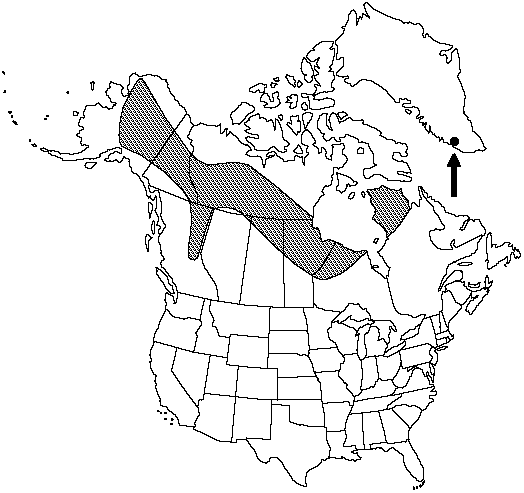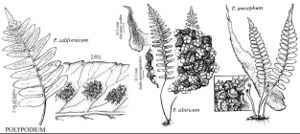Difference between revisions of "Polypodium sibiricum"
Novosti Sist. Vyssh. Rast. 11: 329. 1974.
FNA>Volume Importer |
GeoffLevin (talk | contribs) (Added Nunavut to distribution; treatment was published before Nunavut split from N.W.T.) |
||
| (8 intermediate revisions by 2 users not shown) | |||
| Line 8: | Line 8: | ||
}} | }} | ||
|common_names=Polypode de Sibérie | |common_names=Polypode de Sibérie | ||
| + | |special_status={{Treatment/ID/Special_status | ||
| + | |code=F | ||
| + | |label=Illustrated | ||
| + | }} | ||
|basionyms= | |basionyms= | ||
|synonyms= | |synonyms= | ||
| Line 17: | Line 21: | ||
}}<!-- | }}<!-- | ||
| − | --><span class="statement" id="st- | + | --><span class="statement" id="st-undefined" data-properties=""><b>Stems </b>often whitish pruinose, slender, to 6 mm diam., acrid-tasting; scales concolored to weakly bicolored, uniformly dark brown, often lighter near base, lanceolate, contorted distally, margins denticulate. <b>Leaves</b> to 25 cm. <b>Petiole</b> slender, to 1 mm diam. <b>Blade</b> oblong-linear, pinnatifid, usually widest at or near middle, to 4 cm wide, somewhat leathery; rachis sparsely scaly to glabrescent abaxially, glabrous adaxially; scales lanceolate-ovate, usually more than 6 cells wide. <b>Segments</b> oblong, less than 7 mm wide; margins entire to crenulate; apex rounded to broadly acute; midrib glabrous adaxially. <b>Venation</b> free. <b>Sori</b> midway between margin and midrib to nearly marginal, less than 3 mm diam., circular when immature. <b>Sporangiasters</b> present, less than 40 per sorus, heads normally without glandular hairs. <b>Spores</b> less than 52 µm, tuberculate with tubercles, surface projections more than 3 µm tall. <b>2n</b> = 74.</span><!-- |
-->{{Treatment/Body | -->{{Treatment/Body | ||
| + | |phenology=Sporulating summer–early fall. | ||
|habitat=Cracks and ledges on rock outcrops, on a variety of substrates including granite and dolomite | |habitat=Cracks and ledges on rock outcrops, on a variety of substrates including granite and dolomite | ||
|elevation=100–1000 m | |elevation=100–1000 m | ||
| − | |distribution=Greenland;Alta.;B.C.;Man.;N.W.T.;Ont.;Que.;Sask.;Yukon;Alaska;n Asia. | + | |distribution=Greenland;Alta.;B.C.;Man.;N.W.T.;Nunavut;Ont.;Que.;Sask.;Yukon;Alaska;n Asia. |
| − | |discussion=<p>This boreal diploid has traditionally been identified as Polypodium virginianum (T. M. C. Taylor 1970; F. A. Lang 1971), but recent investigations indicate that it is conspecific with the eastern Eurasian species P. sibiricum (C. H. Haufler and M. D. Windham 1991). The sporangiasters of P. sibiricum normally lack glands, but some collections have sporangiasters with a few glandular hairs. Although such collections could be misidentified, the spores of P. sibiricum are less than 52 µm and clearly distinguish it from P. virginianum, P. amorphum, and P. saximontanum. Hybridization occurs between P. sibiricum and P. virginianum where these species overlap in Canada, forming triploid individuals with misshapen spores (C. H. Haufler and Wang Z. R. 1991).</p> | + | |discussion=<p>This boreal diploid has traditionally been identified as <i>Polypodium virginianum</i> (T. M. C. Taylor 1970; F. A. Lang 1971), but recent investigations indicate that it is conspecific with the eastern Eurasian species <i>P. sibiricum</i> (C. H. Haufler and M. D. Windham 1991). The sporangiasters of <i>P. sibiricum</i> normally lack glands, but some collections have sporangiasters with a few glandular hairs. Although such collections could be misidentified, the spores of <i>P. sibiricum</i> are less than 52 µm and clearly distinguish it from <i>P. virginianum</i>, <i>P. amorphum</i>, and <i>P. saximontanum</i>. Hybridization occurs between <i>P. sibiricum</i> and <i>P. virginianum</i> where these species overlap in Canada, forming triploid individuals with misshapen spores (C. H. Haufler and Wang Z. R. 1991).</p> |
|tables= | |tables= | ||
|references= | |references= | ||
| Line 32: | Line 37: | ||
-->{{#Taxon: | -->{{#Taxon: | ||
name=Polypodium sibiricum | name=Polypodium sibiricum | ||
| − | |||
|authority=Siplivinskij | |authority=Siplivinskij | ||
|rank=species | |rank=species | ||
| Line 39: | Line 43: | ||
|basionyms= | |basionyms= | ||
|family=Polypodiaceae | |family=Polypodiaceae | ||
| + | |phenology=Sporulating summer–early fall. | ||
|habitat=Cracks and ledges on rock outcrops, on a variety of substrates including granite and dolomite | |habitat=Cracks and ledges on rock outcrops, on a variety of substrates including granite and dolomite | ||
|elevation=100–1000 m | |elevation=100–1000 m | ||
| − | |distribution=Greenland;Alta.;B.C.;Man.;N.W.T.;Ont.;Que.;Sask.;Yukon;Alaska;n Asia. | + | |distribution=Greenland;Alta.;B.C.;Man.;N.W.T.;Nunavut;Ont.;Que.;Sask.;Yukon;Alaska;n Asia. |
|reference=None | |reference=None | ||
|publication title=Novosti Sist. Vyssh. Rast. | |publication title=Novosti Sist. Vyssh. Rast. | ||
|publication year=1974 | |publication year=1974 | ||
| − | |special status= | + | |special status=Illustrated |
| − | |source xml=https:// | + | |source xml=https://bitbucket.org/aafc-mbb/fna-data-curation/src/2e0870ddd59836b60bcf96646a41e87ea5a5943a/coarse_grained_fna_xml/V2/V2_116.xml |
|genus=Polypodium | |genus=Polypodium | ||
|species=Polypodium sibiricum | |species=Polypodium sibiricum | ||
| − | |||
| − | |||
| − | |||
| − | |||
| − | |||
| − | |||
| − | |||
| − | |||
| − | |||
| − | |||
| − | |||
| − | |||
| − | |||
| − | |||
| − | |||
| − | |||
| − | |||
| − | |||
| − | |||
| − | |||
| − | |||
| − | |||
| − | |||
| − | |||
| − | |||
| − | |||
| − | |||
| − | |||
| − | |||
| − | |||
| − | |||
}}<!-- | }}<!-- | ||
-->[[Category:Treatment]][[Category:Polypodium]] | -->[[Category:Treatment]][[Category:Polypodium]] | ||
Latest revision as of 17:32, 24 September 2021
Stems often whitish pruinose, slender, to 6 mm diam., acrid-tasting; scales concolored to weakly bicolored, uniformly dark brown, often lighter near base, lanceolate, contorted distally, margins denticulate. Leaves to 25 cm. Petiole slender, to 1 mm diam. Blade oblong-linear, pinnatifid, usually widest at or near middle, to 4 cm wide, somewhat leathery; rachis sparsely scaly to glabrescent abaxially, glabrous adaxially; scales lanceolate-ovate, usually more than 6 cells wide. Segments oblong, less than 7 mm wide; margins entire to crenulate; apex rounded to broadly acute; midrib glabrous adaxially. Venation free. Sori midway between margin and midrib to nearly marginal, less than 3 mm diam., circular when immature. Sporangiasters present, less than 40 per sorus, heads normally without glandular hairs. Spores less than 52 µm, tuberculate with tubercles, surface projections more than 3 µm tall. 2n = 74.
Phenology: Sporulating summer–early fall.
Habitat: Cracks and ledges on rock outcrops, on a variety of substrates including granite and dolomite
Elevation: 100–1000 m
Distribution

Greenland, Alta., B.C., Man., N.W.T., Nunavut, Ont., Que., Sask., Yukon, Alaska, n Asia.
Discussion
This boreal diploid has traditionally been identified as Polypodium virginianum (T. M. C. Taylor 1970; F. A. Lang 1971), but recent investigations indicate that it is conspecific with the eastern Eurasian species P. sibiricum (C. H. Haufler and M. D. Windham 1991). The sporangiasters of P. sibiricum normally lack glands, but some collections have sporangiasters with a few glandular hairs. Although such collections could be misidentified, the spores of P. sibiricum are less than 52 µm and clearly distinguish it from P. virginianum, P. amorphum, and P. saximontanum. Hybridization occurs between P. sibiricum and P. virginianum where these species overlap in Canada, forming triploid individuals with misshapen spores (C. H. Haufler and Wang Z. R. 1991).
Selected References
None.
